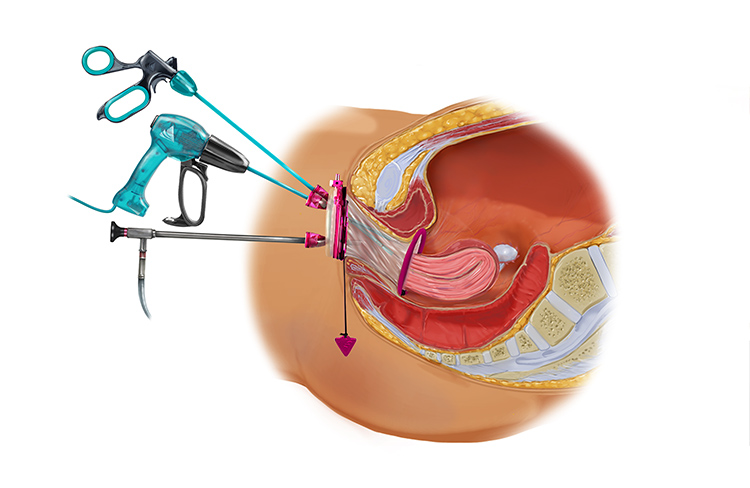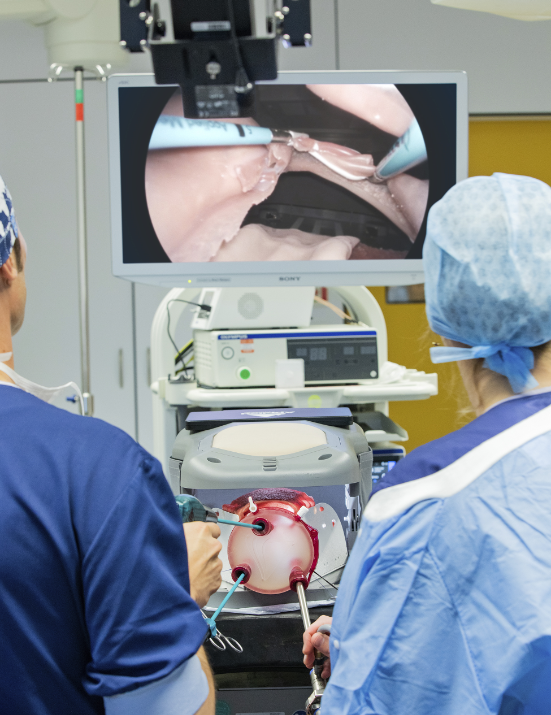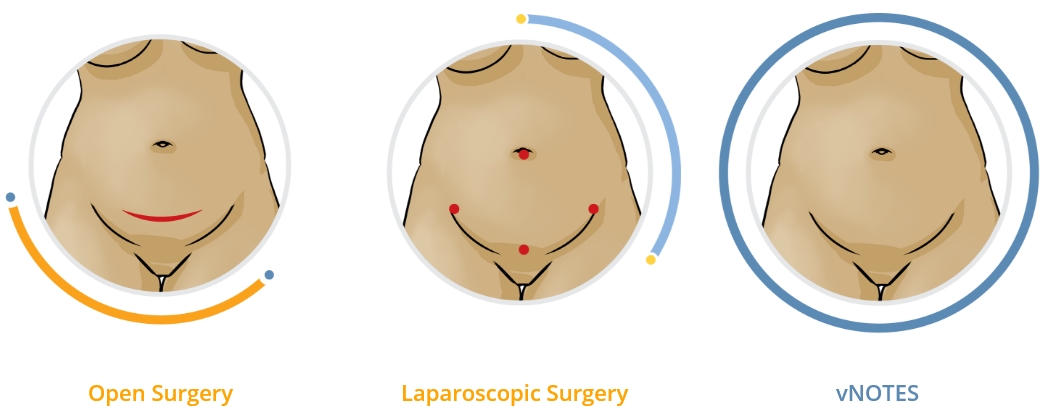This web page is intended exclusively for healthcare professionals.
Vaginal hysterectomy is the recommended approach by ACOG (American College of Obstetricians and Gynecologists), AAGL (American Association of Gynecologic Laparoscopists), Cochrane, and ISGE (International Society for Gynecologic Endoscopy) whenever indicated and
feasible.1,2,3,4 Despite these recommendations and supporting clinical evidence, the global rate of vaginal hysterectomies appears to have steadily declined. Some of the challenges that contribute to lower adoption
of the vaginal approach include lack of visibility and reduced access to the anatomy. Access to the
adnexa can be particularly challenging, with failure rates of up to 36%.5,6
vNOTES (vaginal natural orifice transluminal endoscopic surgery) modernizes vaginal surgery. Innovative
advanced access platforms enable access into the peritoneal cavity through the vagina, effectively
combining the benefits of laparoscopic and traditional vaginal surgery.

“vNOTES solves the challenges of vaginal surgery by allowing additional visualization. It enables you to see the patient’s anatomy, as well as any scar tissue or adhesions. Also, as surgeons, we find it helps us teach our residents how to perform surgery correctly and safely.”
- Erica Stockwell, DO, MBA, FACOGvNOTES peer to peer workshops provide a comprehensive understanding of vNOTES procedural steps and instrumentation used in the treatment of benign gynecologic pathologies. The workshop includes the following:
Didactic lectures reviewing indications, clinical literature, anatomy, and instrument placement
Hands-on practicum with lifelike Simsei® tissue models to simulate vNOTES
Expert guidance and feedback from the faculty
Continued education and support after workshop completion
Thank you!
Your submission has been received.

This site is not intended for patients residing in Australia, Austria, Denmark, France, Italy, Japan, Korea, New Zealand, Portugal, Switzerland, Turkey or UAE.
You play an important role in your surgery and your recovery. Research shows that patients who know more about their surgery choices enjoy a better outcome and are happier with their results.2

vNOTES (vaginal natural orifice transluminal endoscopic surgery) is another choice to consider for your hysterectomy and other gynecologic procedures. vNOTES is a minimally invasive surgery that eliminates the need for your surgeon to make incisions in your abdomen to perform the surgery.

In the vNOTES procedure, your doctor uses specialized instruments inserted through the vagina instead of making incisions in your abdomen. This allows your doctor to gain access to the uterus and/or fallopian tubes and ovaries without any visible scarring.

vNOTES has been shown to provide the following benefits to patients compared to the laparoscopic approach.1

“I was really surprised when I was in recovery, because I could get up on my own and I could move and go to the restroom. The little things you don’t expect you would be able to do for a while, I was able to do very, very quickly, I mean right after surgery.”
- Brittany Villeneuve“The vNOTES procedure and my surgeon ... made it possible for me to just have a little blip on life and just keep going, and I feel so much better after the procedure!”
- Melissa Arrowood“The surgery started at 9 a.m. and I went home by noon that day. I was not in any pain at the hospital. I never experienced any pain with this vNOTES procedure.”
- Dawn Wagner
Your doctor will inform you of any pre-surgery testing and will provide information on eating, drinking and taking medications.

You will be put under general anesthesia and will not feel anything during the procedure.
A small incision will be made in the vagina to help place the vNOTES device.
Your abdomen will then be filled with gas to give your doctor more space to see and operate.
Your doctor will operate with the help of a camera and instruments placed through the vNOTES
device.
After your doctor has completed the surgery, the vNOTES device will be removed, the gas will be
released, and your abdomen will return to normal. The internal incision will then be stitched.

You may be able to go home as early as the same day as your surgery.
A follow-up appointment will be scheduled a few weeks after surgery.
Only a trained doctor can determine whether you are eligible for a vNOTES procedure. All minimally invasive surgical procedures, including vNOTES, present risks to the patient, such as the potential for conversion to a traditional vaginal, laparoscopic or abdominal approach. These specific risks may only be evaluated in consultation with a doctor experienced in vNOTES procedures.
The information on the page you are about to enter is intended for healthcare professionals only.
By clicking the box below you confirm that you are a healthcare professional.
Il semble que vous soyez en France à la recherche d’informations sur la chirurgie vaginale endoscopique par voie
naturelle.
Please speak with your healthcare professional to learn more about vNotes.
Si vous êtes un professionnel de santé, veuillez contacter le service Client d'Applied Medical à CustomerRelationsFR@appliedmedical.com. Sinon, merci de vous rapprocher de votre professionnel de santé pour en savoir plus sur la chirurgie vaginale endoscopique par voie naturelle.
This web page is intended exclusively for healthcare professionals.
Vaginal hysterectomy is the recommended approach by ACOG (American College of Obstetricians and Gynecologists), AAGL (American Association of Gynecologic Laparoscopists), Cochrane, and ISGE (International Society for Gynecologic Endoscopy), whenever indicated and feasible.1-4 Despite these recommendations and supporting clinical evidence, the global rate of vaginal hysterectomies appears to have steadily declined. Some of the challenges that contribute to lower adoption of the vaginal approach include lack of visibility and reduced access to the anatomy. Access to the adnexa can be particularly challenging, with failure rates of up to 36%.5,6
vNOTES (vaginal natural orifice transluminal endoscopic surgery) modernizes vaginal surgery. Innovative advanced access platforms enable access into the peritoneal cavity through the vagina, effectively combining the benefits of laparoscopic and traditional vaginal surgery.

“Patients are very surprised at the rapidity of the recovery. Most of the time, they are very, very happy after the experience. They say, 'If I had known, I would have done it before!'”
- Géraldine Giraudet, MD, PhDJoin us as Drs. Jean Dubuisson (Switzerland), Géraldine Giraudet (France) and Grover May (United States) share how they have advanced their practices with vNOTES. Observe case presentations and listen to a Q&A on how to approach complex cases, such as adnexal procedures and the removal of large uteri, with the vNOTES approach.
Watch EventJoin us as Drs. Asha Bhalwal (United States), Brandi Hardin (United States) and Jay Matkins (United States) review a complete vNOTES hysterectomy, including patient selection, OR and GelPOINT® V-Path platform setup, colpotomy creation, postoperative care and patient outcomes.
Watch EventvNOTES workshops provide a comprehensive understanding of vNOTES procedural steps and instrumentation used in the treatment of benign gynecologic pathologies. The workshop includes the following:
Online didactic lectures reviewing indications, clinical literature, anatomy and instrument placement
Hands-on practicum with lifelike Simsei® tissue models to simulate vNOTES
Expert guidance and feedback from expert faculty
Continued education and support after workshop completion
Thank you!
Your submission has been received.

Pour le moment, ce site web n'est pas disponible pour votre pays.
Si vous êtes un professionnel de santé, veuillez contacter votre représentant local d'Applied Medical ou CustomerRelations-FR@appliedmedical.com pour plus d'informations.
Vaginal hysterectomy is the recommended approach by ACOG (American College of Obstetricians and Gynecologists), AAGL (American Association of Gynecologic Laparoscopists), Cochrane, and ISGE (International Society for Gynecologic Endoscopy), whenever indicated and feasible.1-4 Despite these recommendations and supporting clinical evidence, the global rate of vaginal hysterectomies appears to have steadily declined. Some of the challenges that contribute to lower adoption of the vaginal approach include lack of visibility and reduced access to the anatomy. Access to the adnexa can be particularly challenging, with failure rates of up to 36 percent.5,6
vNOTES (vaginal natural orifice transluminal endoscopic surgery) modernizes vaginal surgery. Innovative advanced access platforms enable access into the peritoneal cavity through the vagina, effectively combining the benefits of laparoscopic and traditional vaginal surgery.

“My patients often experience many benefits from the vNOTES procedure. In addition to not having a scar, they have less postoperative pain, often requiring only ibuprofen. Most importantly, they have a shorter hospital stay and are able to return to work more quickly.”
- Grover May, MD, FACOGvNOTES peer-to-peer workshops provide a comprehensive understanding of vNOTES procedural steps and instrumentation used in the treatment of benign gynecologic pathologies. The workshop includes the following:
Online didactic lectures reviewing indications, clinical literature, anatomy and instrument placement
Hands-on practicum with lifelike Simsei® tissue models to simulate vNOTES
Guidance and feedback from expert faculty
Continued education and support after workshop completion
Thank you!
Your submission has been received.

Vaginal hysterectomy is the recommended approach by ACOG (American College of Obstetricians and Gynecologists), AAGL (American Association of Gynecologic Laparoscopists), Cochrane, and ISGE (International Society for Gynecologic Endoscopy), whenever indicated and feasible.1-4 Despite these recommendations and supporting clinical evidence, the global rate of vaginal hysterectomies appears to have steadily declined. Some of the challenges that contribute to lower adoption of the vaginal approach include lack of visibility and reduced access to the anatomy. Access to the adnexa can be particularly challenging, with failure rates of up to 36 percent.5,6
vNOTES (vaginal natural orifice transluminal endoscopic surgery) modernizes vaginal surgery. Innovative advanced access platforms enable access into the peritoneal cavity through the vagina, effectively combining the benefits of laparoscopic and traditional vaginal surgery.

“vNOTES solves the challenges of vaginal surgery by allowing additional visualization. It enables you to see the patient’s anatomy, as well as any scar tissue or adhesions. Also, as surgeons, we find it helps us teach our residents how to perform surgery correctly and safely.”
- Erica Stockwell, DO, MBA, FACOGvNOTES peer-to-peer workshops provide a comprehensive understanding of vNOTES procedural steps and instrumentation used in the treatment of benign gynecologic pathologies. The workshop includes the following:
Online didactic lectures reviewing indications, clinical literature, anatomy and instrument placement
Hands-on practicum with lifelike Simsei® tissue models to simulate vNOTES
Guidance and feedback from expert faculty
Continued education and support after workshop completion
Thank you!
Your submission has been received.
